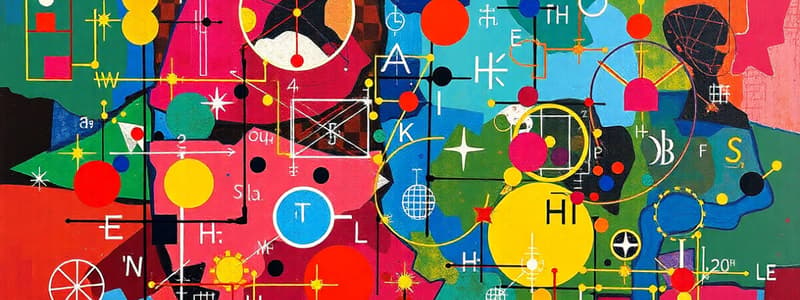Podcast
Questions and Answers
What is the primary focus of calculus?
What is the primary focus of calculus?
- Basic operations like addition and subtraction
- Collection and analysis of data
- Change and motion, including derivatives and integrals (correct)
- Study of shapes and sizes
Which theorem states that in a right triangle, the sum of the squares of the legs equals the square of the hypotenuse?
Which theorem states that in a right triangle, the sum of the squares of the legs equals the square of the hypotenuse?
- Fundamental Theorem of Calculus
- Newton's Law
- Pythagorean Theorem (correct)
- Fundamental Theorem of Algebra
In statistics, what do the mean, median, and mode represent?
In statistics, what do the mean, median, and mode represent?
- Parameters for data standardization
- Measures of central tendency (correct)
- Methods for interpreting variance
- Types of errors in data collection
Which of the following correctly represents the formula for the area of a circle?
Which of the following correctly represents the formula for the area of a circle?
What is the purpose of the order of operations in mathematics?
What is the purpose of the order of operations in mathematics?
Which of the following defines a polynomial?
Which of the following defines a polynomial?
What term describes the measure of how much data varies from the mean in a set?
What term describes the measure of how much data varies from the mean in a set?
What is a key property of triangles regarding their interior angles?
What is a key property of triangles regarding their interior angles?
What does Pi (π) approximately equal?
What does Pi (π) approximately equal?
Which of the following best describes a constant in mathematics?
Which of the following best describes a constant in mathematics?
What is the base of natural logarithms known as?
What is the base of natural logarithms known as?
What is one suggested method for mastering mathematical concepts?
What is one suggested method for mastering mathematical concepts?
Which symbol represents a mathematical operation such as addition or multiplication?
Which symbol represents a mathematical operation such as addition or multiplication?
Flashcards are hidden until you start studying
Study Notes
Key Concepts in Mathematics
1. Branches of Mathematics
- Arithmetic: Basic operations - addition, subtraction, multiplication, division.
- Algebra: Use of symbols and letters to represent numbers and quantities in formulas and equations.
- Geometry: Study of shapes, sizes, and properties of figures and spaces.
- Calculus: Focuses on change and motion; includes derivatives and integrals.
- Statistics: Collection, analysis, interpretation, presentation of data.
- Probability: Study of uncertainty and the likelihood of events occurring.
2. Fundamental Theorems
- Pythagorean Theorem: In a right triangle, (a^2 + b^2 = c^2) (where (c) is the hypotenuse).
- Fundamental Theorem of Algebra: Every non-constant polynomial has at least one complex root.
- Fundamental Theorem of Calculus: Links differentiation and integration, providing a way to evaluate definite integrals.
3. Mathematical Operations
- Order of Operations: Parentheses, Exponents, Multiplication and Division (left to right), Addition and Subtraction (left to right) - PEMDAS.
- Factorization: Breaking down a number or expression into multiple factors that can be multiplied together.
- Functions: Relation between a set of inputs and a set of possible outputs, defined by a rule.
4. Algebraic Concepts
- Equations: Mathematical statements that assert equality; can be linear or nonlinear.
- Inequalities: Expressions indicating the relative size or order of values.
- Polynomials: Expressions consisting of variables and coefficients, involving operations like addition, multiplication, and non-negative integer exponents.
5. Geometry Principles
- Types of Angles: Acute, obtuse, right, straight, reflex.
- Properties of Triangles: Sum of interior angles equals 180°, types include isosceles, equilateral, scalene.
- Circles: Key elements include radius, diameter, circumference, area ((A = \pi r^2)).
6. Calculus Concepts
- Limits: The value that a function approaches as the input approaches some value.
- Derivatives: Measure the rate of change of a quantity; slope of the tangent line to the curve.
- Integrals: Summation of areas under curves; can be definite or indefinite.
7. Statistics Fundamentals
- Mean, Median, Mode: Measures of central tendency.
- Standard Deviation: Indicates how much data varies from the mean.
- Probability Distributions: Describe how probabilities are distributed over the values of the random variable.
8. Important Mathematical Constants
- Pi (π): Approximately 3.14, represents the ratio of the circumference of a circle to its diameter.
- Euler's Number (e): Approximately 2.718, the base of natural logarithms, important in calculus and complex analysis.
9. Mathematical Language
- Variables: Symbols (often letters) used to represent numbers in equations.
- Constants: Fixed values that do not change.
- Operators: Symbols that represent mathematical operations (e.g., +, −, ×, ÷).
10. Practice and Application
- Regular practice is key to mastery.
- Utilize real-world problems to apply mathematical concepts.
- Use online resources and textbooks for additional exercises and explanations.
Branches of Mathematics
- Arithmetic deals with basic operations like addition, subtraction, multiplication, and division.
- Algebra uses symbols and letters to represent numbers and quantities in formulas and equations.
- Geometry studies the shapes, sizes, and properties of figures and spaces.
- Calculus focuses on change and motion, including derivatives and integrals.
- Statistics involves collecting, analyzing, interpreting, and presenting data.
- Probability studies uncertainty and the likelihood of events occurring.
Fundamental Theorems
- Pythagorean Theorem states that in a right triangle, the square of the hypotenuse (the side opposite the right angle) is equal to the sum of the squares of the other two sides: (a^2 + b^2 = c^2).
- Fundamental Theorem of Algebra states that every non-constant polynomial with complex coefficients has at least one complex root.
- Fundamental Theorem of Calculus establishes a relationship between differentiation and integration, allowing for the evaluation of definite integrals.
Mathematical Operations
- Order of Operations is a set of rules that dictate the order in which operations should be performed in a mathematical expression. The acronym PEMDAS (Parentheses, Exponents, Multiplication and Division, Addition and Subtraction) is commonly used to remember the order.
- Factorization involves breaking down a number or expression into multiple factors that can be multiplied together.
- Functions represent a relationship between a set of inputs and a set of possible outputs, defined by a rule.
Algebraic Concepts
- Equations are mathematical statements that assert equality. They can be linear (straight lines) or nonlinear (curves).
- Inequalities are expressions that indicate the relative size or order of values.
- Polynomials are expressions consisting of variables and coefficients, involving operations like addition, multiplication, and non-negative integer exponents.
Geometry Principles
- Angles can be classified as acute (less than 90 degrees), obtuse (greater than 90 degrees), right (exactly 90 degrees), straight (180 degrees), or reflex (greater than 180 degrees).
- Triangles have specific properties, including the fact that the sum of their interior angles always equals 180 degrees. Different types of triangles include isosceles (two equal sides), equilateral (all sides equal), and scalene (all sides different).
- Circles have key elements like the radius (distance from the center to the edge), diameter (distance across the circle through the center), circumference (distance around the circle), and area ((A = \pi r^2)).
Calculus Concepts
- Limits describe the value that a function approaches as the input approaches a certain value.
- Derivatives measure the rate of change of a quantity. They represent the slope of the tangent line to the curve at a specific point.
- Integrals represent the summation of areas under curves. They can be definite (with defined limits of integration) or indefinite (without specific limits).
Statistics Fundamentals
- Mean, Median, Mode are measures of central tendency, representing the average, middle value, and most frequent value in a dataset, respectively.
- Standard Deviation measures how much data varies from the mean.
- Probability Distributions describe how probabilities are distributed over the values of a random variable.
Important Mathematical Constants
- Pi (π) is approximately 3.14, representing the ratio of a circle's circumference to its diameter.
- Euler's Number (e) is approximately 2.718 and serves as the base of natural logarithms. It plays a significant role in calculus and complex analysis.
Mathematical Language
- Variables are symbols, usually letters, used to represent numbers in equations.
- Constants are fixed values that do not change.
- Operators are symbols that represent mathematical operations, such as addition (+), subtraction (−), multiplication (×), and division (÷).
Practice and Application
- Regular practice is essential for achieving mastery in mathematics.
- Applying mathematical concepts to real-world problems enhances understanding and retention.
- Utilize online resources and textbooks for additional exercises and explanations.
Studying That Suits You
Use AI to generate personalized quizzes and flashcards to suit your learning preferences.




